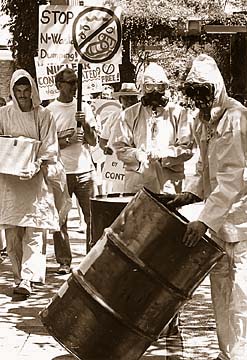


Amid din of
development, comes
voice of ecology
After a long struggle,
By Richard Borreca
the community is conscious
of the wealth of nature
Star-BulletinWe were killing the coral with raw sewage and soil runoff. We were going to blow out the ozone layer with supersonic transports that would also be killing coral as they landed on a new reef runway.
Surfing, our sport of kings, was going to be as flat as Waimea Bay in August thanks to developers, city planners and the Army Corps of Engineers' misguided efforts to redesign the shoreline.
We had decided that the view of Diamond Head was not as attractive or lucrative as billboards. And we also thought Magic Island and Ala Moana would be great places for a string of hotels.
We knew that boring another freeway through the Koolaus was more important than preserving remnants of the Hawaiian culture.
That is the general view of Hawaii's near-death experiences, according to the supporters of the state's environmental movement.
"Short-sighted development and environmental destruction has been greeted with community opposition in every generation," says David Frankel, chairman of the Hawaii chapter of the Sierra Club.
"Each battle has inspired a new generation of environmental leaders."
Early attempts to preserve the environment were the focus of the Outdoor Circle, which is credited with leading the fight to ban billboards in Hawaii and also protect the views of Diamond Head.
But the dispute over Hawaii's limited resources was not always that benign. Haunani-Kay Trask, activist and later director of the University of Hawaii's Hawaiian Studies Center, in 1981 wrote about how the 1971 occupation of Kalama Valley in East Honolulu was a signal event for both the Hawaiian and environmental movements.
Protesters tried unsuccessfully to block the development of the farming valley that emptied onto Sandy Beach. During the struggle, the groups banned together under the banner, Kokua Hawaii. Later they published a set of guidelines as relevant today as it was nearly three decades ago:
"Significant resistance efforts throughout the decade would raise these issues again and again," Trask said.Save farm lands.
Halt immigration until local needs are handled.
Care for Hawaii's air, land and water.
Take back the land from the big landholders.
Learn to be self-sufficient.
"Local people could no longer be counted on to move aside without a fight. The social and political cost of development would occupy center stage for years to come."
In the 1980s, many East Honolulu residents, including those in Kalama Valley, protested to keep Sandy Beach from being developed. It was just this year that Gov. Ben Cayetano approved the state's purchase of the shoreline to protect it from development.
At the same time, Hawaii's government became more aware of the political power of the environmental movement. Endorsements by groups such as the Sierra Club, Life of the Land, and Save Our Surf are now just as valuable as a union's approval.
And, government itself has become more aware and supportive of Hawaii's environment, as both chambers of the state Legislature have standing committees dealing with environmental protection.
The Honolulu Star-Bulletin is counting down to year 2000 with this special series. Each installment will chronicle important eras in Hawaii's history, featuring a timeline of that particular period. Next installment: November 8. About this Series
Series Archive
Project Editor: Lucy Young-Oda
Chief Photographer:Dean Sensui